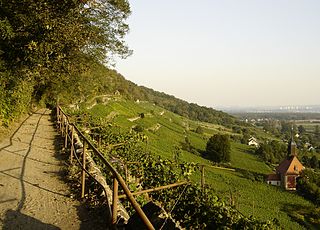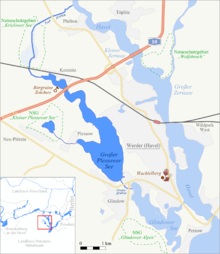
Sauvignon blanc is a green-skinned grape variety that originates from the city of Bordeaux in France. The grape most likely gets its name from the French words sauvage ("wild") and blanc ("white") due to its early origins as an indigenous grape in South West France. It is possibly a descendant of Savagnin. Sauvignon blanc is planted in many of the world's wine regions, producing a crisp, dry, and refreshing white varietal wine. The grape is also a component of the famous dessert wines from Sauternes and Barsac. Sauvignon blanc is widely cultivated in France, Chile, Romania, Canada, Australia, New Zealand, South Africa, Bulgaria, the states of Oregon, Washington, and California in the US. Some New World Sauvignon blancs, particularly from California, may also be called "Fumé Blanc", a marketing term coined by Robert Mondavi in reference to Pouilly-Fumé.

Viticulture or winegrowing is the cultivation and harvesting of grapes. It is a branch of the science of horticulture. While the native territory of Vitis vinifera, the common grape vine, ranges from Western Europe to the Persian shores of the Caspian Sea, the vine has demonstrated high levels of adaptability to new environments, hence viticulture can be found on every continent except Antarctica.

Chile has a long history in the production of wine, with roots dating back to the 16th century when the Spanish conquistadors introduced Vitis vinifera vines to the region. In the mid-19th century, French wine varieties such as Cabernet Sauvignon, Merlot, Carmenère, and Franc were introduced. During the early 1980s, the Chilean wine industry underwent a renaissance with the introduction of stainless steel fermentation tanks and the use of oak barrels for aging. This led to a rapid growth in exports as quality wine production increased. The number of wineries in Chile rose from 12 in 1995 to over 70 in 2005.

German wine is primarily produced in the west of Germany, along the river Rhine and its tributaries, with the oldest plantations going back to the Roman era. Approximately 60 percent of German wine is produced in the state of Rhineland-Palatinate, where 6 of the 13 regions (Anbaugebiete) for quality wine are situated. Germany has about 103,000 hectares of vineyard, which is around one tenth of the vineyard surface in Spain, France or Italy. The total wine production is usually around 10 million hectoliters annually, corresponding to 1.3 billion bottles, which places Germany as the eighth-largest wine-producing country in the world. White wine accounts for almost two thirds of the total production.

Wrattonbully is a wine region in the Limestone Coast region of South Australia's South East, between the Padthaway and Coonawarra regions, between the Riddoch Highway and the Victorian border.

The Central Otago wine region is a geographical indication in New Zealand's South Island, and the world's southernmost commercial wine growing region. While Central Otago is best known for Pinot Noir, many white wine varieties are also popular.

The Alexander Valley is a Californian American Viticultural Area (AVA) just north of Healdsburg in Sonoma County. It is home to many wineries and vineyards, as well as the city of Cloverdale. It is the largest and most fully planted wine region in Sonoma. Highway 101 runs through the valley, and the Russian River flows down the valley, surrounded by vineyards on both sides. From the higher elevations of the valley rim, there is a view as far south as Taylor Mountain and Sonoma Mountain. The region was named for Cyrus Alexander, owner of a part of the Rancho Sotoyome Mexican land grant, in 1847. Granted AVA status in 1984, the boundaries of the appellation are defined in the Code of Federal Regulations, Title 27, Section 9.53.

Argentina is the fifth largest producer of wine in the world. Argentine wine, as with some aspects of Argentine cuisine, has its roots in Spain. During the Spanish colonization of the Americas, vine cuttings were brought to Santiago del Estero in 1557, and the cultivation of the grape and wine production stretched first to neighboring regions, and then to other parts of the country.

Werder (Havel) (official name derived from Werder an der Havel ("Werder upon Havel"), colloquially just Werder) is a town in the state of Brandenburg, Germany, located on the Havel river in the Potsdam-Mittelmark district, west of the state's capital Potsdam.

Washington wine is a wine produced from grape varieties grown in the U.S. state of Washington. Washington ranks second in the United States in the production of wine. By 2017, the state had over 55,000 acres (220 km2) of vineyards, a harvest of 229,000 short tons (208,000 t) of grapes, and exports going to over 40 countries around the world from the 940+ wineries located in the state. While there are some viticultural activities in the cooler, wetter western half of the state, the majority (99.9%) of wine grape production takes place in the shrub-steppe eastern half. The rain shadow of the Cascade Range leaves the Columbia River Basin with around 8 inches (200 mm) of annual rain fall, making irrigation and water rights of paramount interest to the Washington wine industry. Viticulture in the state is also influenced by long sunlight hours and consistent temperatures.

The Temecula Valley AVA is an American Viticultural Area in the Temecula Valley, located in southwestern Riverside County, California.

The Mendocino County wine is an appellation that designates wine made from grapes grown mostly in Mendocino County, California. The region is part of the larger North Coast AVA and one of California's largest and most climatically diverse wine growing regions. Mendocino County is one of the northernmost commercial wine grape regions in the state with two distinct climate zones separated by the Mendocino Range. Ten American Viticultural Areas have been designated within Mendocino County. Mendocino is one of the leading wine growing regions for organically produced wine grapes. Nearly 25% of the acreage in Mendocino County is grown organically. In 2004, the residents of the county voted to become the first GMO-free county in the United States in an initiative that was supported by many of the county's largest wineries. The county's widespread focus on organic viticulture has inspired journalists to describe it as "California's organic wine Mecca".

Saxony (Sachsen) is a region for quality wine in Germany located in the German federal state of Saxony. The region is sometimes referred to colloquially as the Elbtal. The wine region covers 462 hectares, which makes it Germany's third smallest region, just ahead of Mittelrhein and Hessische Bergstraße in size. It is situated along the Elbe river from the Pillnitz section of Dresden to the village of Diesbar-Seußlitz located north of Meissen. Together with the Saale-Unstrut wine region, Saxony is one of the northernmost wine regions in Europe and are the only two of Germany's 13 wine regions that are located in the former East Germany. After German reunification in 1990, the vineyard surface was expanded from 200 to 450 hectares with European Union subsidies, but in recent years the vineyard area has decreased.

California wine production has a rich viticulture history since 1680 when Spanish Jesuit missionaries planted Vitis vinifera vines native to the Mediterranean region in their established missions to produce wine for religious services. In the 1770s, Spanish missionaries continued the practice under the direction of the Father Junípero Serra who planted California's first vineyard at Mission San Juan Capistrano.

The El Dorado AVA is an American Viticultural Area located in El Dorado County, California, United States. Wine grape growers in the region produce a large diversity of varietals, notable varietals are Zinfandel, Barbera, Cabernet Sauvignon, Merlot and Petite Sirah and there are significant plantings of Rhône varietals. Located in the foothills of the Sierra Nevada mountains, vineyards are found primarily at elevations between 600 feet (183 m) and 3,500 feet (1,067 m) above sea level and some of the historic and revered vineyards are planted above 2,000 feet (610 m) elevation. The region benefits from the cool breezes that come off the mountains and push hot air off the vines and down to the valley. The soils of the region are magma based with high levels of acidity.

The Eola-Amity Hills AVA is an American Viticultural Area located in Polk County and Yamhill County, Oregon. It is entirely contained within the Willamette Valley AVA, and stretches from the city of Amity in the north to Salem in the south. The Eola and Amity hills cover an area west of the Willamette River approximately 15 miles (24 km) long by 6 miles (10 km) wide. The Eola-Amity Hills area benefits from steady winds off the Pacific Ocean that reach the Willamette Valley through the Van Duzer Corridor, a gap in the Oregon Coast Range, moderating the summer temperatures. The Eola Hills were named after the community of Eola, whose name was derived from Aeolus, the Greek god of the winds.

New South Wales wine is Australian wine produced in New South Wales, Australia. New South Wales is Australia's most populous state and its wine consumption far outpaces the region's wine production. The Hunter Valley, located 130 km (81 mi) north of Sydney, is the most well-known wine region but the majority of the state's production takes place in the Big Rivers zone-Perricoota, Riverina and along the Darling and Murray Rivers. The wines produced from the Big Rivers zone are largely used in box wine and mass-produced wine brands such as Yellow Tail. A large variety of grapes are grown in New South Wales, including Cabernet Sauvignon, Chardonnay, Shiraz and Sémillon.
This glossary of viticultural terms list some of terms and definitions involved in growing grapes for use in winemaking.

Irrigation in viticulture is the process of applying extra water in the cultivation of grapevines. It is considered both controversial and essential to wine production. In the physiology of the grapevine, the amount of available water affects photosynthesis and hence growth, as well as the development of grape berries. While climate and humidity play important roles, a typical grape vine needs 25-35 inches of water a year, occurring during the spring and summer months of the growing season, to avoid stress. A vine that does not receive the necessary amount of water will have its growth altered in a number of ways; some effects of water stress are considered desirable by wine grape growers.

In viticulture, the climates of wine regions are categorised based on the overall characteristics of the area's climate during the growing season. While variations in macroclimate are acknowledged, the climates of most wine regions are categorised as being part of a Mediterranean, maritime or continental climate. The majority of the world's premium wine production takes place in one of these three climate categories in locations between the 30th parallel and 50th parallel in both the northern and southern hemisphere. While viticulture does exist in some tropical climates, most notably Brazil, the amount of quality wine production in those areas is so small that the climate effect has not been as extensively studied as other categories.





















